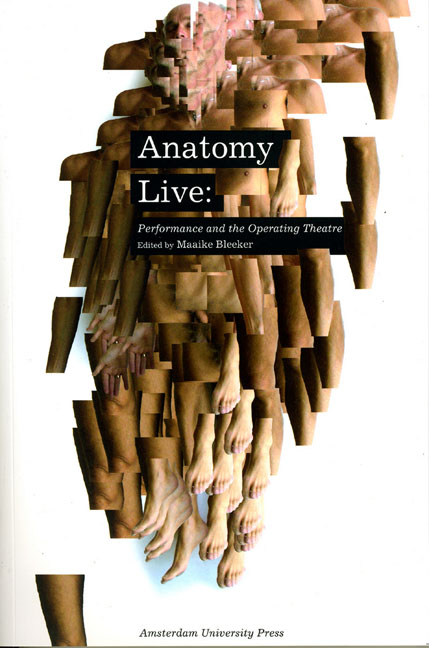Book contents
- Frontmatter
- Contents
- Acknowledgements
- Prologue - Men with Glass Bodies
- Introduction
- Performance Documentation 1: Holoman; Digital Cadaver
- Digital Cadavers and Virtual Dissection
- ‘Who Were You?’: The Visible and the Visceral
- Performance Documentation 2: Excavations: Fresh but Rotten
- The Anatomy Lesson of Professor Moxham
- ‘Be not Faithless But Believing’: Illusion and Doubt in the Anatomy Theatre
- Performance Documentation 3: De Anatomische Les
- Of Dissection and Technologies of Culture in Actor Training Programs – an Example from 1960s West Germany
- Ocular Anatomy, Chiasm, and Theatre Architecture as a Material Phenomenology in Early Modern Europe
- Performance Documentation 4: Camillo – Memo 4.0: The Cabinet of Memories – A Tear Donnor Session
- Martin, Massumi, and the Matrix
- Performance Documentation 5: Sensing Presence no 1: Performing a Hyperlink System
- ‘Where Are You Now?’: Locating the Body in Contemporary Performance
- Performance Documentation 6: Under My Skin
- Anatomies of Live Art
- Performance Documentation 7: Crash
- Restaging the Monstrous
- Delirium of the Flesh: ‘All the Dead Voices’ in the Space of the Now
- Performance Documentation 8: Körper
- Operating Theatres: Body-bits and a Post-apartheid Aesthetics
- Index
‘Be not Faithless But Believing’: Illusion and Doubt in the Anatomy Theatre
Published online by Cambridge University Press: 10 February 2021
- Frontmatter
- Contents
- Acknowledgements
- Prologue - Men with Glass Bodies
- Introduction
- Performance Documentation 1: Holoman; Digital Cadaver
- Digital Cadavers and Virtual Dissection
- ‘Who Were You?’: The Visible and the Visceral
- Performance Documentation 2: Excavations: Fresh but Rotten
- The Anatomy Lesson of Professor Moxham
- ‘Be not Faithless But Believing’: Illusion and Doubt in the Anatomy Theatre
- Performance Documentation 3: De Anatomische Les
- Of Dissection and Technologies of Culture in Actor Training Programs – an Example from 1960s West Germany
- Ocular Anatomy, Chiasm, and Theatre Architecture as a Material Phenomenology in Early Modern Europe
- Performance Documentation 4: Camillo – Memo 4.0: The Cabinet of Memories – A Tear Donnor Session
- Martin, Massumi, and the Matrix
- Performance Documentation 5: Sensing Presence no 1: Performing a Hyperlink System
- ‘Where Are You Now?’: Locating the Body in Contemporary Performance
- Performance Documentation 6: Under My Skin
- Anatomies of Live Art
- Performance Documentation 7: Crash
- Restaging the Monstrous
- Delirium of the Flesh: ‘All the Dead Voices’ in the Space of the Now
- Performance Documentation 8: Körper
- Operating Theatres: Body-bits and a Post-apartheid Aesthetics
- Index
Summary
Michelangelo Caravaggio 's painting of 1603, titled The Incredulity of Saint Thomas, depicts one scene from the New Testament biblical narrative concerned with the resurrection of Christ, described in detail in the Gospel of John. Following his crucifixion, Christ appears to the disciples and reveals the wounds of the crucifixion as proof of his identity, death and resurrection. For reasons not articulated in the narrative, Thomas, another disciple, was not amongst them for this visitation. Unable to accept on faith what his fellow apostles describe, Thomas demands proof of his own before acknowledging the truth of the resurrection: ‘Except I shall see in his hands the print of the nails, and put my finger into the place of the nails, and put my hand into his side, I will not believe’ ( John 20:25). He desires to touch and explore Christ's wounds and only by thus invading the body interior, by mimicking the trajectories of the penetrating objects through firstly vision and then tactility, will Thomas concede the miracle of the resurrection. For Thomas at least, seeing is not fully believing.
Some eight days later, Christ again appears to the disciples, and Thomas, this time amongst their number, is invited by Christ to dispel his scepticism: ‘Put in thy finger hither, and see my hands. And bring hither thy hand, and put it into my side: and be not faithless but believing’ ( John 20:27). Here, there is a strange aporia in the text, for it is not clear whether or not Thomas does touch any of the wounds or whether the sight of the dead Christ embodied is simply enough to dispel his doubt. He moves instantaneously from seeking tactile empirical evidence to articulating a rhetoric of belief: ‘My Lord and my God’ is his only reply, according to the narrative ( John 20:28). In religious iconography of the scene, however, the aporia in the text is often negated in favour of a Thomas who is compelled to make contact with the wound. Caravaggio likewise makes no bones about the aporia – Thomas impinges upon the marks of the crucifixion by plunging his finger into the spear wound on Christ's torso, guided there by the touch of the resurrected man himself and embedded in the flesh.
- Type
- Chapter
- Information
- Anatomy LivePerformance and the Operating Theatre, pp. 93 - 110Publisher: Amsterdam University PressPrint publication year: 2008
- 1
- Cited by



